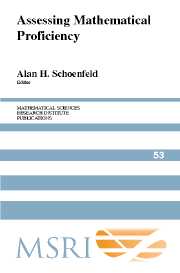Book contents
- Frontmatter
- Contents
- Preface
- Acknowledgments
- Section 1 The Big Picture
- Section 2 Perspectives on Mathematical Proficiency
- Section 3 What Does Assessment Assess? Issues and Examples
- 6 Mathematical Proficiency: What Is Important? How Can It Be Measured?
- 7 Aspects of the Art of Assessment Design
- 8 Mathematical Proficiency for Citizenship
- 9 Learning from Assessment
- 10 When Assessment Guides Instruction: Silicon Valley's Mathematics Assessment Collaborative
- Section 4 The Case of Algebra
- Section 5 What Do Assessments Assess? The Case of Fractions
- Section 6 The Importance of Societal Context
- Epilogue: What Do We Need to Know? Items for a Research Agenda
- About the Authors
- Subject Index
- Author Index
- Task Index
6 - Mathematical Proficiency: What Is Important? How Can It Be Measured?
Published online by Cambridge University Press: 06 July 2010
- Frontmatter
- Contents
- Preface
- Acknowledgments
- Section 1 The Big Picture
- Section 2 Perspectives on Mathematical Proficiency
- Section 3 What Does Assessment Assess? Issues and Examples
- 6 Mathematical Proficiency: What Is Important? How Can It Be Measured?
- 7 Aspects of the Art of Assessment Design
- 8 Mathematical Proficiency for Citizenship
- 9 Learning from Assessment
- 10 When Assessment Guides Instruction: Silicon Valley's Mathematics Assessment Collaborative
- Section 4 The Case of Algebra
- Section 5 What Do Assessments Assess? The Case of Fractions
- Section 6 The Importance of Societal Context
- Epilogue: What Do We Need to Know? Items for a Research Agenda
- About the Authors
- Subject Index
- Author Index
- Task Index
Summary
This chapter examines important aspects of mathematical performance, and illustrates how they may be measured by assessments of K–12 students, both by high-stakes external examinations and in the classroom. We address the following questions:
Who does assessment inform? Students? Teachers? Employers? Universities? Governments?
What is assessment for? To monitor progress? To guide instruction? To aid or justify selection? To provide system accountability?
What aspects of mathematical proficiency are important and should be assessed? Quick calculation? The ability to use knowledge in a new situation? The ability to communicate precisely?
When should assessment occur to achieve these goals? Daily? Monthly? Yearly? Once?
What will the consequences of assessment be? For students? For teachers? For schools? For parents? For politicians?
What will it cost, and is the necessary amount an appropriate use of resources?
There are, of course, multiple answers to each of these interrelated questions. Each collection of answers creates a collection of constraints whose satisfaction may require a mix of different kinds of assessment: summative tests, assessment embedded in the curriculum, and daily informal observation and feedback in the classroom. Rather than discuss each type of assessment, this chapter describes principles that should guide the choice of a system of assessment tasks created with these questions in mind, particularly the third: What aspects of mathematical proficiency are important and should be assessed? Every assessment is based on a system of values, often implicit, where choices have to be made (see [NRC 2001], for example); here I seek to unpack relationships between aspects of mathematical proficiency and types of assessment tasks, so the choices can be considered and explicit.
- Type
- Chapter
- Information
- Assessing Mathematical Proficiency , pp. 77 - 98Publisher: Cambridge University PressPrint publication year: 2007
- 4
- Cited by



